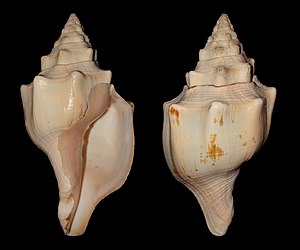Turbinella angulata
| Turbinella angulata | ||||||||||||
|---|---|---|---|---|---|---|---|---|---|---|---|---|

Housing of Turbinella angulata |
||||||||||||
| Systematics | ||||||||||||
|
||||||||||||
| Scientific name | ||||||||||||
| Turbinella angulata | ||||||||||||
| ( Lightfoot , 1786) |
Turbinella angulata is the name of a snail from the family of turbinellidae (genus Turbinella ), which in the western Atlantic and the Caribbean is widespread. It feeds mainly on polychaetes .
features
The large, heavy, spindle-shaped snail shell of Turbinella angulata reaches a length of about 13 to 25 cm, sometimes up to 50 cm in adult snails and has about 6 whorls. The thread is moderately high with a bluntly rounded apex. The case is sculpted with 8 to 10 protruding ribs that are angled at the shoulder. The spindle has 3 strong folds. The surface of the shell is colored white, while the inside of the case mouth can be pink or orange.
Distribution and occurrence
Turbinella angulata is distributed in the western Atlantic Ocean from the Florida Keys and Bahamas to Cuba , the Dominican Republic , Jamaica and Haiti as well as on the Caribbean coast of Mexico , Belize , Honduras , Nicaragua , Costa Rica , Panama and Colombia .
Turbinella angulata lives in the intertidal zone and below on sand and mud as well as on rocks and in mangroves at depths of up to 45 m.
food
Turbinella angulata feeds on Vielborstern as well as by injection worms , among others, the genus Siphonosoma .
Life cycle
Like other new snails, Turbinella angulata is separate sexes. The male mates with the female with his penis . The development of the finished snail takes place entirely within the egg capsules, which are rich in egg white for nutrition.
Web links
Individual evidence
- ^ R. Tucker Abbott, Percy A. Morris: A Field Guide to Shells: Atlantic and Gulf Coasts and the West Indies. Houghton Mifflin Harcourt, Boston 2001. pp. 283f.
- ↑ a b c Turbinella angulata (Lightfoot, 1786), West Indian chank. Sealife Base, accessed May 7, 2018.
- ↑ a b Malacog - A Database of Western Atlantic Marine Mollusca
- ^ Turbinella angulata (Lightfoot, 1786) , WoRMS , accessed May 7, 2018.
- ↑ Claudio Galli: WMSDB - Worldwide Mollusc Species Data Base
- ↑ Hardy's Internet Guide to Marine Gastropods
- ↑ Chank Egg Cases. Jim Conrad's Naturalist Newsletter, accessed May 7, 2018.
- ^ Smithsonian Tropical Research Institute info
- ^ CE Edwards (1970): Caught with a mouthful - Turbinella (Xancus). Miami Malacological Society Quarterly 4, p. 15.
- ^ AJ Kohn (1983): The feeding biology of gastropods. In: ASM Saleuddin, KM Wilbur (ed.): The Mollusca, 5. Physiology, Part 2. pp. 1-64. Academic Press, London.
- ↑ Frank Riedel: Origin and evolution of the "higher" Caenogastropoda . Berliner Geoscientific Abhandlungen, Series E, Volume 32, Berlin 2000. P. 111.
